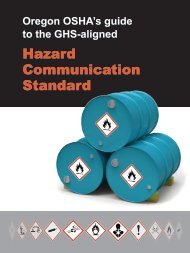Technical Manual - Section 3 (Safety Hazards)
Technical Manual - Section 3 (Safety Hazards)
Technical Manual - Section 3 (Safety Hazards)
Create successful ePaper yourself
Turn your PDF publications into a flip-book with our unique Google optimized e-Paper software.
Figure III:2-4 Typical Alkenes<br />
Pyrophoric iron sulfide results from the corrosive action of<br />
sulfur compounds on the iron and steel used in refinery<br />
process equipment, piping, and tanks. The combustion of<br />
petroleum products containing sulfur compounds produces<br />
undesirables such as sulfuric acid and sulfur dioxide.<br />
Catalytic hydrotreating processes such as<br />
hydrodesulfurization remove sulfur compounds from refinery<br />
product streams. Sweetening processes either remove the<br />
obnoxious sulfur compounds or convert them to odorless<br />
disulfides, as in the case of mercaptans.<br />
OXYGEN COMPOUNDS<br />
Oxygen compounds such as phenols, ketones, and carboxylic<br />
acids occur in crude oils in varying amounts.<br />
NITROGEN COMPOUNDS<br />
Nitrogen is found in lighter fractions of crude oil as basic<br />
compounds, and more often in heavier fractions of crude oil<br />
as nonbasic compounds that may also include trace metals<br />
such as copper, vanadium, and/or nickel. Nitrogen oxides can<br />
form in process furnaces. The decomposition of nitrogen<br />
compounds in catalytic cracking and hydrocracking processes<br />
forms ammonia and cyanides that can cause corrosion .<br />
TRACE METALS<br />
Metals including nickel, iron, and vanadium are often found<br />
in crude oils in small quantities and are removed during the<br />
refining process. Burning heavy fuel oils in refinery furnaces<br />
Figure III:2-5. Typcial Diolefins and Alkynes<br />
III:2-8
















